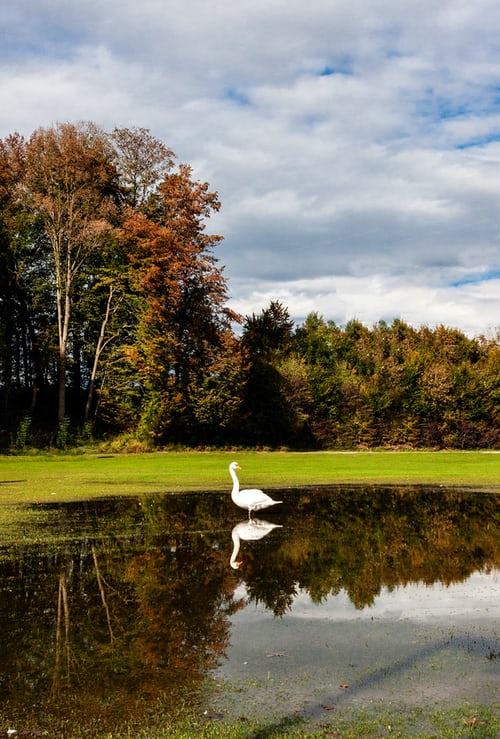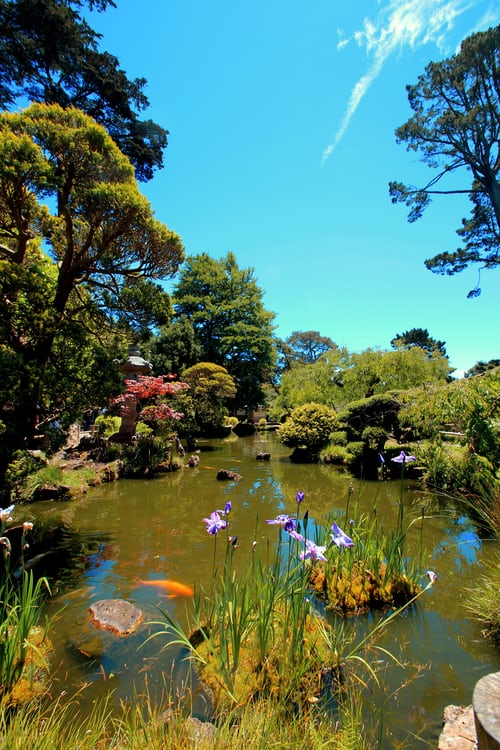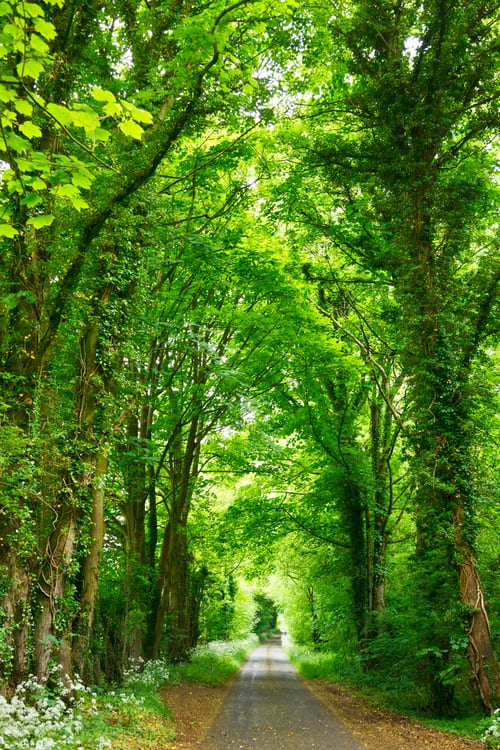Seasonal care
The key to a dream water garden is seasonal garden pond maintenance and the key to low pond maintenance is to establish and maintain an ecological balance.
The 5 Keys to establishing an ecological balance....
- Choose plants from each of the 5 Pond Zones (see Zone Map) to create a well balanced selection.
- Don’t add more fish than your pond and filter will support and don’t over feed your fish.
- Choose the right pump to circulate and aerate the pond water.
Choose the right skimmer and biological filtration system. - Lots of rocks and pebbles to create a habitat for beneficial bacteria.
Preventative garden pond maintenance
Preventative garden pond maintenance is better than a full overhaul. Ideally a full pond clean should be done as infrequently as possible.
When should I clean out my pond?
This varies according to each pond. If you have a lot of debris from over hanging trees, then you should clean it more regularly, using only partial water changes.
Many pond owners leave the cleaning too late. There is more debris and therefore more work. Often, leaves are left in the bottom of the pond from Autumn. They sink to the bottom during Winter and slowly decompose. When the water warms up in Spring, the leaves begin to decompose faster, fouling the water, promoting disease and releasing a large amount of nutrients which in turn increases algal growth.
After each clean you should add beneficial bacteria and enzymes to encourage the healthy break down the remaining small amounts of debris.
Healthy pond water is the key to a successful pond....
Why you shouldn't remove all the pond water?
A pond is not like a swimming pool. You shouldn’t be trying to create a sterile, chemically dependent pool.
Each pond establishes an ecological balance over time. Sometimes this may take 12 months. If you dump all the water, you need to start the whole process all over again. Apart from plants and fish, a pond also contains a vast number of microorganisms. Many of these are beneficial bacteria, that help to recycle the debris and waste that accumulates in the pond. They convert this waste into valuable nutrients for plants.
By only replacing a portion of the water, you minimise the changes to the water chemistry. Leaving some of the beneficial ecology in the pond to re-establish more quickly and help stabilise the pond.
How much Water should I remove when cleaning my pond?
A partial water change is highly recommended before the water starts to warm in Spring. If the pond is well maintained, as little as 25% of the pond water may be removed to freshen things up.
If there is an accumulation of dead leaves and other debris then you may need to remove 50% or more during garden pond maintenance.
100% changes should only be done if the water features have no plants, fish or other aquatic life.
The only time that you would remove all the water from a pond with aquatic life is if the pond needed a complete garden pond maintenance overhaul, or you were losing plants and fish due to the poor health in the pond.
If you can, try to top up the pond only using a trickle of water over a few days. This will allow the pond water to stabilise better and fish, like most aquatic life, don’t like sudden changes to their water chemistry. If replacing water more quickly, then you may need to add a dechlorinator product.
Seasonal Pond Maintenance
Whenever undertaking any garden pond maintenance, a partial water change allows us to inspect the condition of the pond. While the water level is still low, each piece of equipment should be inspected for wear and damage, including the pumps, filters, lights – and all the cables, tubing and connections. It may seem like a nuisance to repair or replace items, but it would be worse to deal with in mid-summer when everything in the pond is looking its best.
Check the pond liner, pond sealant membrane or the preformed pond’s overall condition. Small tears or punctures may need to be patched, and evidence of larger damage or degradation may indicate that it’s time for replacement or upgrading to better materials.
Preventative garden pond maintenance is better than a full overhaul. Check the surrounding landscape to see if soil and debris wash into the pond. If so, try to divert the drainage away, as it will save lots of work in the future. Natural bacteria can break down a lot of organic debris, but soil will just accumulate and result in sediment build up and increased maintenance.

Pond Winter Maintenance
Don’t be misled by information that does not relate to Australia.
Many Northern Hemisphere water gardens undergo more severe Winters than what we endure here in Australia. Much of their information does not really relate to the conditions that our ponds tolerate. So unless you have a pond in the (relatively low) Alpine regions in Australia, we do not need to be concerned with “Winterisation” of the pond. We don’t need to remove all our plants to stop them from freezing solid.
Oz Watergardens have grown Hardy Water lilies and even some Tropical ones in areas where the pond freezes over. The water beneath the surface ice is still fine for the dormant plants to over Winter successfully.
When should I clean out the pond?
What is often referred to as a Spring Clean, can be done earlier in Australia, due to our warmer climate. In the Tropics, pond winter maintenance can involve a complete overhaul if required. To do this job, in the heat of Summer, would not be pleasant for yourself or your plants. Whilst in Southern Australia, we recommend that pond clean outs be undertaken late Winter (as the water starts to warm ever so slightly).
During the cooler months, fish and other aquatic animals’ metabolism slows. They are unable to efficiently digest many of the supplementary foods. So it is generally best to reduce or if the water temperatures drop below 10°C, not to feed at all. There are usually insects and other sources of food available, so they won’t starve.
Pond Winter Maintenance - to do list
- Water change. Remove no more than 25% of the pond water. If the pond has fish, take care not to accidently remove them too. You may need to screen the fish away from where you are removing the water.
- Remove containerized plants so that they can be trimmed, divided, re-potted. Store them in a shady area. Cover with a plastic drop sheet to prevent leaves drying out, while cleaning the pond.
- Trim back dead leaves from plants around the pond edges in order to remove debris that may begin to decompose in the pond water.
- Unplug the pump/s, UV filters, lights and any other electrical pond accessories. Remove these accessories from the pond water to gently clean and inspect them for wear or damage. Gently rinse the filters and replace filter mats if they start to tear apart as you handle them. Use a soft brush to clean pumps, check hose fittings, replace as necessary. Gently clean pond lights and check that there are no leaks or blown globes. It is easier to test the lights when they are out of the pond.
- Remove any debris, such as leaves or twigs, by hand. Use a net and/or a pond vacuum to remove as much of the accumulated debris as practical.
- Inspect the water feature for leaks, cracks or any other signs of damage.
- Return the pond accessories into place. Plug in and test them (provided that there is sufficient water over them).
- Rinse the pond edges, from the upper edges down. A little cloudiness is normal.
- If all is functioning well, return and gently lower the plants back into the pond water. Some plants (eg. Japanese Iris ) do not over-Winter as well and are best kept out of the pond at this time.
- Refill the pond slowly. If you have the time, a slow trickle is best. If not, you may need to add a dechlorinator to neutralize the chlorine from the tap water.
- Add some beneficial enzymes and bacteria to help boost the natural cleaning processes in the pond.
- During the cooler months, fish and other aquatic animals’ metabolism slows. They are unable to efficiently digest many of the supplementary foods. So it is generally best to reduce or if the water temperatures drop below 10°C, not to feed at all. There are usually insects and other sources of food available, so they won’t starve.
Spring Pond Maintenance
- Water Change. Remove no more than 25% of the pond water. If the pond has fish, take care not to accidently remove them too. You may need to screen the fish away from where you are removing the water.
- Remove the accummulated debris with a net. A pond vacuum is ideal for this task as you also remove some of the pond water while removing the debris.
- As the water continues to warm up, introduce new plants, particularly water clarifying plants (oxygenating plants) such as Ribbon grass (Vallisnera americana) they will help to compete with the algae for the available nutrients in the pond water.
- Fertilise the plants as they start to show indications of new growth. That’s the plant telling you that it’s Spring for your individual pond. Oz Watergardens have their own Pond Plant fertilizer tablet that are ideally suited and are easy to use. Just make a hole into the pond soil, insert the tablet and cover the soil back over the tablet, so that it doesn’t create more algal problems.
- Monitor the new plant growth for pests, such as aphids. Yes, water plants are just as susceptible to aphids, as roses are. Wash the aphids off with your garden hose and the fish can eat them. If you have more severe out breaks, you may need to remove the affected plants and spray them. If you have fish, you can start to feed them again.
- Check and clean filters
- Add some beneficial enzymes and bacteria to help boost the natural cleaning processes in the pond

Summer Pond Maintenance
- Water Change. Remove no more than 25% of the pond water. A pond vacuum is ideal for this task as you can also remove some of the debris.
- Remove the accummulated debris with a net. A pond vacuum is ideal for this task as you also remove some of the pond water while removing the debris.
- Monitor the plant growth for pests and treat if necessary.
- If growth has diminished and water lilies aren’t flowering too well, then many plants will respond well to being fertilized again.
- Trim back excess growth. Try to keep the open pond surface to 50% of the pond area. Higher than 50% leaf coverage reduces gas exchange. Warmer water holds less oxygen and excessive leaf coverage lowers the potential area available for gas exchange.
- Check that pumps are working efficiently and that there is sufficient aeration of the pond water. Operate waterfalls and fountains more frequently to increase aeration especially towards the night. Plants produce oxygen in sunlight, but they also consume it a night time. Oxygen levels in ponds are often depleted at night in warmer weather.
- Continue to feed the fish
- Check and clean filters.
- Add some beneficial enzymes and bacteria to help boost the natural cleaning processes in the pond.
Autumn Pond Maintenance
- Water Change. Remove no more than 25% of the pond water.
- Continue to vacuum or net the pond debris.
- Monitor the plant growth for pests and treat if necessary.
- Check that pumps are working efficiently and that there is sufficient aeration of the pond water.
- Trim back excess growth or leaves dying back for Winter. This will reduce the excess organic build up and reduce the potential for harmful toxic gas build ups in the pond during Winter.
- Leaf fall from trees may become more of a problem, pond skimmers may fill and block up more frequently. It may be necessary to set up some netting over the pond to capture most of the leaves.
- As the water continues to cool, reduce the amount of food to the fish. Only feed what they can eat within a minute or two.
- Check and clean filters.
- Add some beneficial enzymes and bacteria to help boost the natural cleaning processes in the pond.

Summing up
As you learn what is necessary to keep your water garden clean and healthy, you will find that it is not all that time consuming, or hard to do. The pleasure and enjoyment of learning about your own little ecosystem helps you to appreciate the joys of life and what’s around us. Sit back and enjoy.
TIPS
1. Keep a log book of the tasks you performed and make notes on what happens to your pond, any problems and how you solved them. You will find this a useful tool to look back on.
2. If you need help or more info about aquatic weeds or pond cleaning, go to out Pond maintenance page.